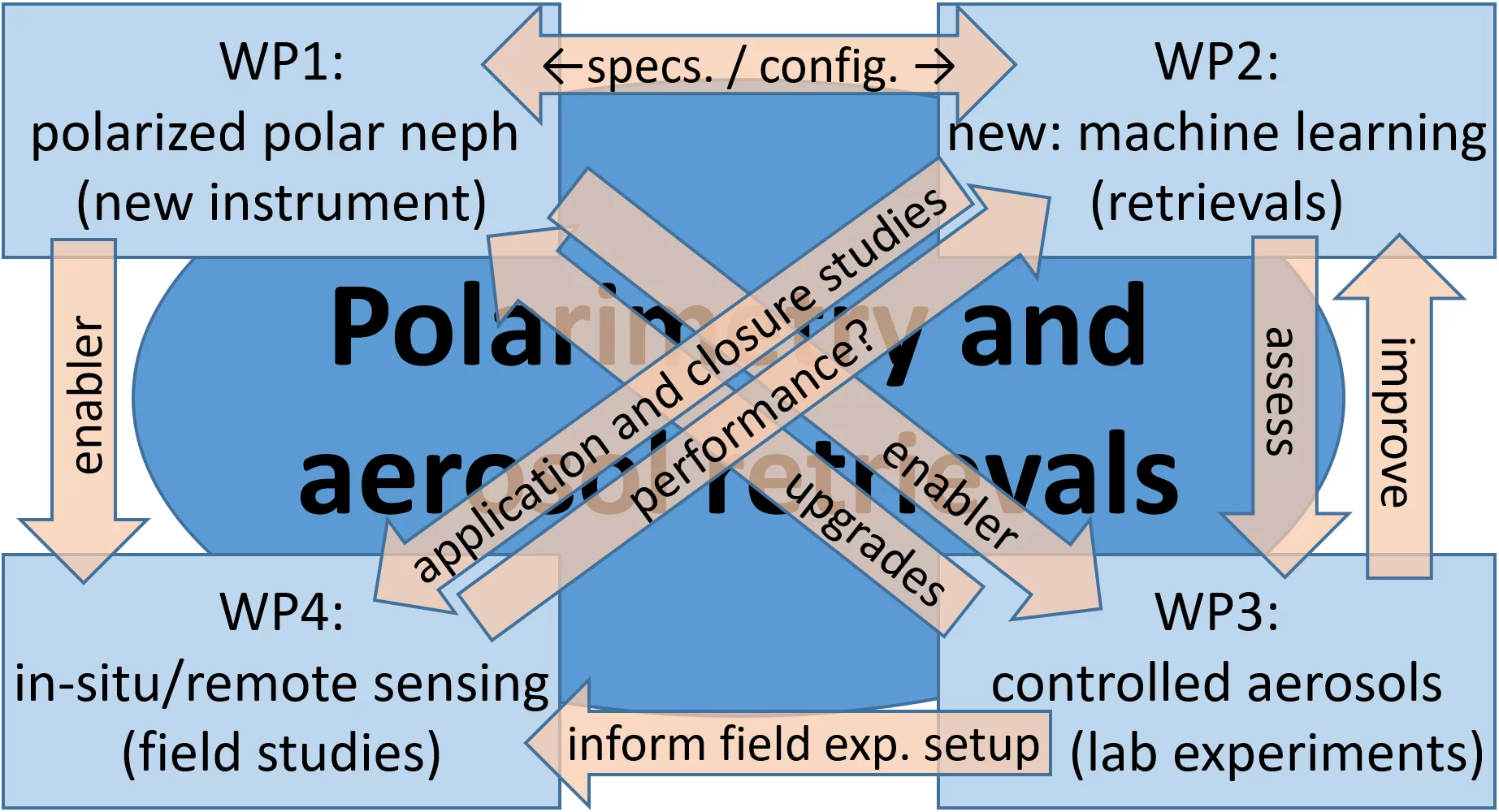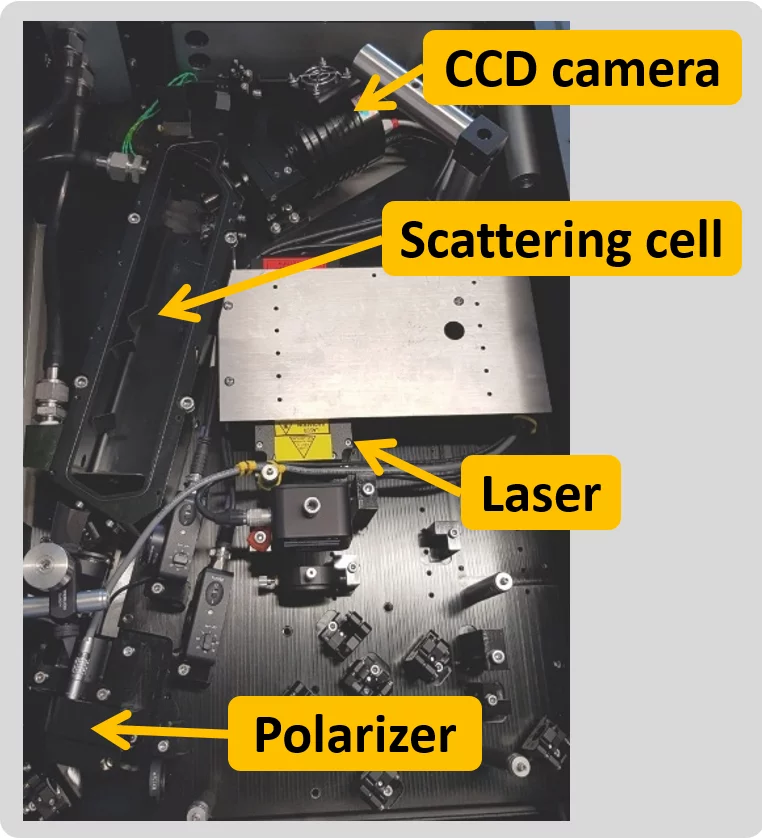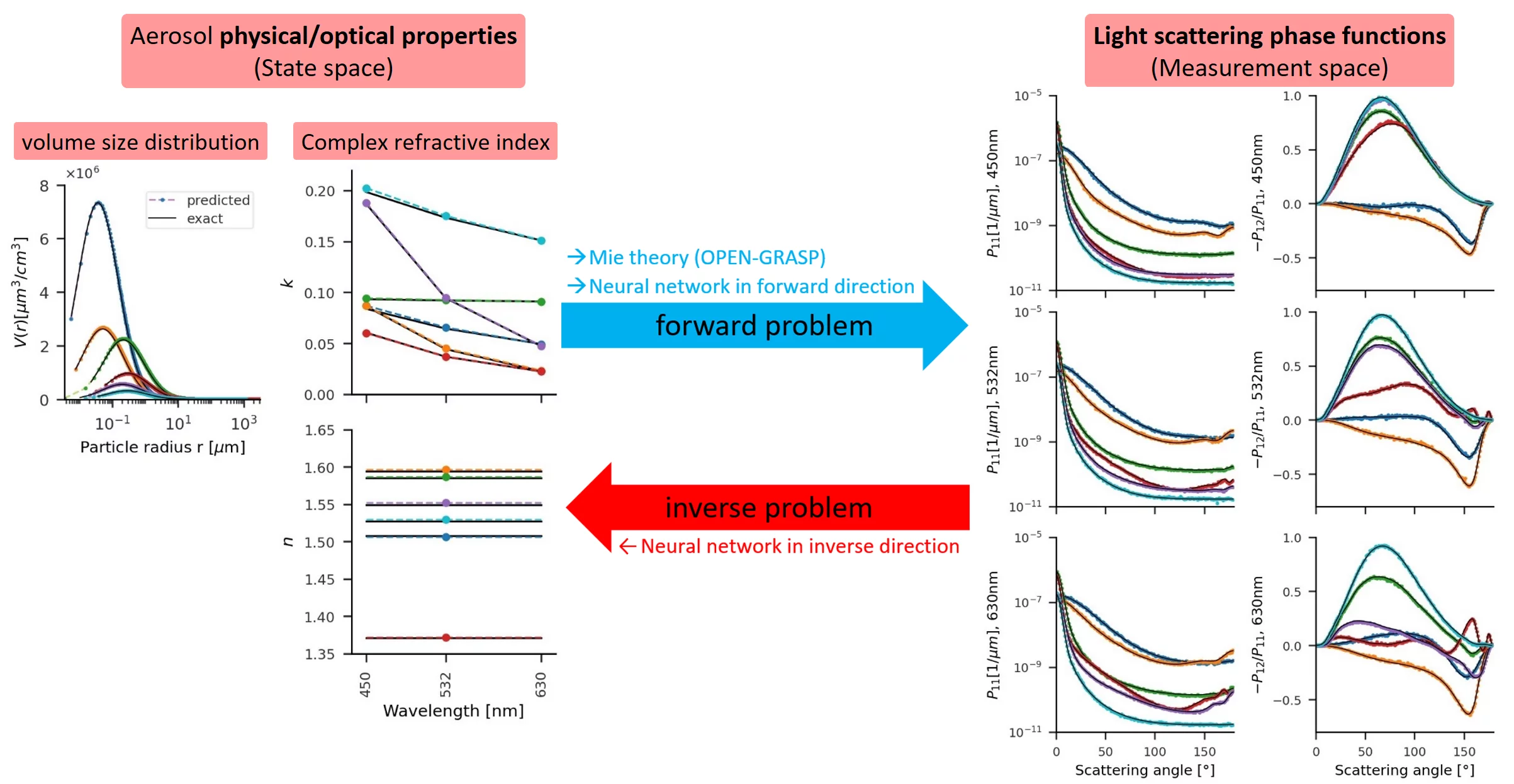Polarimetry to Bridge the Gap between In-Situ and Remote Sensing Observations of Atmospheric Aerosols (BISAR)
Duration: 2022-2025
Funding: Swiss National Science Foundation (SNSF)
Contact: Martin Gysel-Beer (martin.gysel@psi.ch)
Table of Contents
Scope of Project
Atmospheric aerosols are tiny particles that originate from various natural and anthropogenic sources and are suspended in the air in large numbers. The two most important environmental impacts are their negative effects on human health and their influence on weather and climate change. The latter is caused by interaction between aerosols and solar radiation and between aerosols and clouds. Remote sensing methods play an important role in understanding and limiting the impact of aerosols. The properties of aerosols can be probed by polarimetry, i.e. by measuring the angular dependence of light scattering from the particles. However, this requires inversion algorithms to be able to derive the properties sought from the measured scattered light data under simplifying assumptions.
The main objective of this project is to close the gap between in-situ and remote sensing measurements. For this purpose, an in-situ polarimetric measuring device will be further developed and used. This approach will allow independent measurements of the optical and physical properties of aerosols in parallel to polarimetry. The resulting data sets allow to comprehensively characterise aerosols in different environments. The in-situ results can be compared with remote sensing data and used to validate existing inversion algorithms. In addition, the potential of novel neural networks for data inversion will be explored. This should significantly reduce the computational effort.
Work packages
The workplan of this project is organized in four work packages spanning the range from instrument upgrades through development of methods to solve the inverse problem to laboratory and field experiments to probe a range of aerosols and to assess performance of different inversion schemes.
- WP1: Instrument upgrade and validation
- WP2: Data inversion method development, testing and intercomparison
- WP3: Laboratory experiments on various major aerosol components and mixtures
- WP4: Field experiments
First Results
Prototype laser imaging polar nephelometer
Recently, Dolgos et al. (2014) have developed a laser imaging type polar nephelometer for in-situ measurements of aerosol light scattering phase function with high angular resolution.
In a project funded by MeteoSwiss (GAW-CH funding scheme), we started a collaboration with Micos Engineering GmbH to develop our own laser imaging type nephelometer. A first prototype with single wavelength and polarization capabilities was successfully built and validated in laboratory experiments (manuscript is in preparation).
Currently, we work on a design upgrade to include 3 wavelengths covering the full visible spectrum, to improve features such as dynamic range or robustness, and to simplify operation and calibration procedures. The figure shown here presents the inside of the current prototype.
Dolgos, G. and Martins, J. V.: Polarized Imaging Nephelometer for in situ airborne measurements of aerosol light scattering. Opt. Express, 22, 21972-21990, doi:10.1364/OE.22.021972, 2014.
Using invertible neural networks for polarimetric aerosol retrievals
The forward problem of aerosol polarimetry is to calculate the light scattering phase function, that is the polarization and angular dependence of light scattering by an aerosol ensemble. Mie theory offers an exact analytical solution for homogeneous spherical particles, and approximative numerical approaches are commonly used for non-spherical shapes or non-homogeneous particles. These methods can provide accurate phase functions, however, they can be computationally expensive depending on aerosol complexity.
The inverse problem of aerosol polarimetry, that is retrieving aerosol properties such as size distribution, refractive index and shape from measurements of the phase function of an aerosol ensemble, is commonly addressed with traditional least square minimisation or more basic look-up table based approaches. More or less accurate inversion results can be achieved, depending on ill-posedness of the inverse problem, however, computational effort can be high.
Machine learning based approaches potentially offer a pathway that is both accurate and efficient. We made use of recently developed invertible neural networks and trained these to solve both the forward and the inverse problem of aerosol polarimetry. The first specific exercise addressed retrieval of size distribution and complex refractive index parameters of uni- and bimodal aerosols. Results presented in the example here demonstrate that accurate and computationally efficient solutions of forward and inverse problem were successfully achieved (Boiger, R., Modini, R.L., et al., J. Aerosol Sci., in review). This is a promising start, and we will proceed with investigating the strengths and limitations of this approach when it comes to more complex aerosol properties or more ill-posed polarimetric inverse problems.
Publications
Peer-reviewied journal articles
-
Moallemi A, Modini RL, Brem BT, Bertozzi B, Giaccari P, Gysel-Beer M
Concept, absolute calibration, and validation of a new benchtop laser imaging polar nephelometer
Atmospheric Measurement Techniques. 2023; 16(15): 3653-3678. https://doi.org/10.5194/amt-16-3653-2023
DORA PSI -
Moallemi A, Modini RL, Lapyonok T, Lopatin A, Fuertes D, Dubovik O, et al.
Information content and aerosol property retrieval potential for different types of in situ polar nephelometer data
Atmospheric Measurement Techniques. 2022; 15(19): 5619-5642. https://doi.org/10.5194/amt-15-5619-2022
DORA PSI -
Boiger R, Modini RL, Moallemi A, Degen D, Adelmann A, Gysel-Beer M
Retrieval of aerosol properties from in situ, multi-angle light scattering measurements using invertible neural networks
Journal of Aerosol Science. 2022; 163: 105977 (20 pp.). https://doi.org/10.1016/j.jaerosci.2022.105977
DORA PSI
Preprints
None.





